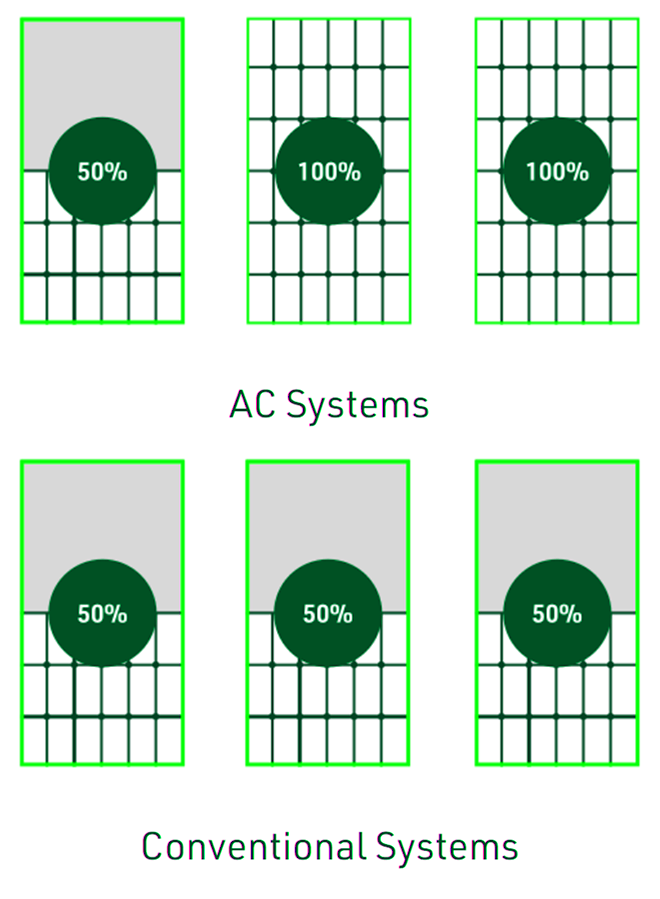How Solar Works
How Solar Works
How will my solar panels generate power?
Simply put, a home solar solution harnesses the power of the sun to produce electricity. This is initially done through solar photovoltaic (PV) panels.
The solar PV panels convert sunlight into DC electricity (direct current) through the photovoltaic effect. This electricity is then fed into a solar inverter and converted into AC (alternating current) power, which is sent to your electrical meter and is then used to power various appliances and devices in your home.
Your home doesn’t always need electricity at all times of the day however. When an excess supply has been generated, the solar energy can be stored or exported. When exporting solar energy, it is sold to electricity retailers at a fairly low cost, which comes back to you as additional funds via a feed-in tariff. Or, if you’d rather stockpile energy for more effective use later down the road, you can store it in a solar battery.
One aspect in the above diagram that may need a little more context, is the mention of “Micro-inverters”. A micro-inverter is a small electronic device installed behind each solar panel in a solar system that converts the DC electricity generated by the panel into AC electricity, that can be used in your home.
This functions exactly the same as a traditional inverter, however it’s; safer (as the more volatile DC electricity doesn’t travel far) and more cost efficient (as the micro-inverters allow for each panel to generate electricity independently from one another, rather than as a string-system where one panel having an issue causes disruption with all the panels).
Every AC panel comes equipped with micro-inverters built in them, converting DC electricity into AC electricity without the need for a dedicated inverter. This feature maximises safety, energy production and efficiency – providing better power production during overcast, shading and rain (typical Tassie environments).

The technology itself also just continues to advance, with a modern solar system providing a 370W average power rating and 15–22% efficiency compared to the 250W and 15% efficiency offered by older panels.
Solar has a bright future in Tasmania, with the federal government’s STC program available to help our transition to renewable energy. This program offers eligible applicants a subsidy on solar panels, hot water and solar batteries. To qualify for this rebate, a SAA-accredited installer must install your system. It is important to ensure that your installer is accredited by the Solar Australia Accreditation to guarantee the quality of your solar system. At TSS, all our installers are SAA-accredited to ensure your installation is safe and reliable.
How will my solar panels generate power?
Simply put, a home solar solution harnesses the power of the sun to produce electricity. This is initially done through solar photovoltaic (PV) panels.
The solar PV panels convert sunlight into DC electricity (direct current) through the photovoltaic effect. This electricity is then fed into a solar inverter and converted into AC (alternating current) power, which is sent to your electrical meter and is then used to power various appliances and devices in your home.
Your home doesn’t always need electricity at all times of the day however. When an excess supply has been generated, the solar energy can be stored or exported. When exporting solar energy, it is sold to electricity retailers at a fairly low cost, which comes back to you as additional funds via a feed-in tariff. Or, if you’d rather stockpile energy for more effective use later down the road, you can store it in a solar battery.
One aspect in the above diagram that may need a little more context, is the mention of “Micro-inverters”. A micro-inverter is a small electronic device installed behind each solar panel in a solar system that converts the DC electricity generated by the panel into AC electricity, that can be used in your home.
This functions exactly the same as a traditional inverter, however it’s; safer (as the more volatile DC electricity doesn’t travel far) and more cost efficient (as the micro-inverters allow for each panel to generate electricity independently from one another, rather than as a string-system where one panel having an issue causes disruption with all the panels).
Every AC panel comes equipped with micro-inverters built in them, converting DC electricity into AC electricity without the need for a dedicated inverter. This feature maximises safety, energy production and efficiency – providing better power production during overcast, shading and rain (typical Tassie environments).

The technology itself also just continues to advance, with a modern solar system providing a 370W average power rating and 15–22% efficiency compared to the 250W and 15% efficiency offered by older panels.
Solar has a bright future in Tasmania, with the federal government’s STC program available to help our transition to renewable energy. This program offers eligible applicants a subsidy on solar panels, hot water and solar batteries. To qualify for this rebate, a SAA-accredited installer must install your system. It is important to ensure that your installer is accredited by the Solar Australia Accreditation to guarantee the quality of your solar system. At TSS, all our installers are SAA-accredited to ensure your installation is safe and reliable.
FAQs
You will retain all of the power that your solar system produces, so in a sense, you are getting paid for what you produce. You can receive credit for the additional energy you create when the sun is out, which can be used for days when there is low energy generation.
Financing your solar system is not only easy but provides an affordable and flexible payment solution and government partnerships access. Our financing options take into account government rebates and offer interest-free, fortnightly payments ranging from 6 to 60-month repayment periods. The approval process is simple, and pre-approval is often granted within minutes.
The National Solar Subsidy significantly reduces the initial investment required for solar panels. The rebate is worth up to $3,914; however, the value depends on the size of the system. For example, a 4kw system will approximately afford a $1,444 rebate, whilst an 8kw system ensues a $2,888 incentive. One of our trained consultants will explain how to access the government subsidy during a consultation.
Maintenance for solar panels is minimal, as your system will still be fully operational regardless of if the panels have some dirt or dust on them. Our advice is if you can see any dirt on the panels with the naked eye, then clean them. There is no need to clean them periodically for the sake of it. If you need to clean the panels, do so with a high-pressure hose for around 5 minutes.
Yes, we have access to battery storage. Of course, whether or not a battery is suitable for your system and energy consumption is case by case; however, many of our current clientele are using battery storage, and the benefits can be significant. These include greater energy security, further reduction of carbon footprint, and access to power during blackout periods.
All properties need electricity to power the home. The rising cost of electricity is a significant concern for all Australian homeowners, so the opportunity to counter these spikes by inheriting a solar system could be a major factor in a potential buyer’s evaluation of your property. Research shows an estimated property value increase of almost $6,000 per kilowatt of solar energy. This indicates a rise of over $29,000 in the home’s retail value for a 5kW installation.
Feed-in tariffs are fixed electricity rates paid to renewable energy producers for every kilowatt-hour of electricity your solar PV system feeds into the grid.
Yes, there is. The solar hot water system uses the sun to directly heat water. A solar PV system converts sunlight into electricity for home use or to be fed into the electricity grid. The sun’s heat output is not crucial for solar PV systems, but the amount of sunlight available definitely is.
Still have questions?
FAQs
You will retain all of the power that your solar system produces, so in a sense, you are getting paid for what you produce. You can receive credit for the additional energy you create when the sun is out, which can be used for days when there is low energy generation.
Financing your solar system is not only easy but provides an affordable and flexible payment solution and government partnerships access. Our financing options take into account government rebates and offer interest-free, fortnightly payments ranging from 6 to 60-month repayment periods. The approval process is simple, and pre-approval is often granted within minutes.
The National Solar Subsidy significantly reduces the initial investment required for solar panels. The rebate is worth up to $3,914; however, the value depends on the size of the system. For example, a 4kw system will approximately afford a $1,444 rebate, whilst an 8kw system ensues a $2,888 incentive. One of our trained consultants will explain how to access the government subsidy during a consultation.
Maintenance for solar panels is minimal, as your system will still be fully operational regardless of if the panels have some dirt or dust on them. Our advice is if you can see any dirt on the panels with the naked eye, then clean them. There is no need to clean them periodically for the sake of it. If you need to clean the panels, do so with a high-pressure hose for around 5 minutes.
Yes, we have access to battery storage. Of course, whether or not a battery is suitable for your system and energy consumption is case by case; however, many of our current clientele are using battery storage, and the benefits can be significant. These include greater energy security, further reduction of carbon footprint, and access to power during blackout periods.
All properties need electricity to power the home. The rising cost of electricity is a significant concern for all Australian homeowners, so the opportunity to counter these spikes by inheriting a solar system could be a major factor in a potential buyer’s evaluation of your property. Research shows an estimated property value increase of almost $6,000 per kilowatt of solar energy. This indicates a rise of over $29,000 in the home’s retail value for a 5kW installation.
Feed-in tariffs are fixed electricity rates paid to renewable energy producers for every kilowatt-hour of electricity your solar PV system feeds into the grid.
Yes, there is. The solar hot water system uses the sun to directly heat water. A solar PV system converts sunlight into electricity for home use or to be fed into the electricity grid. The sun’s heat output is not crucial for solar PV systems, but the amount of sunlight available definitely is.
